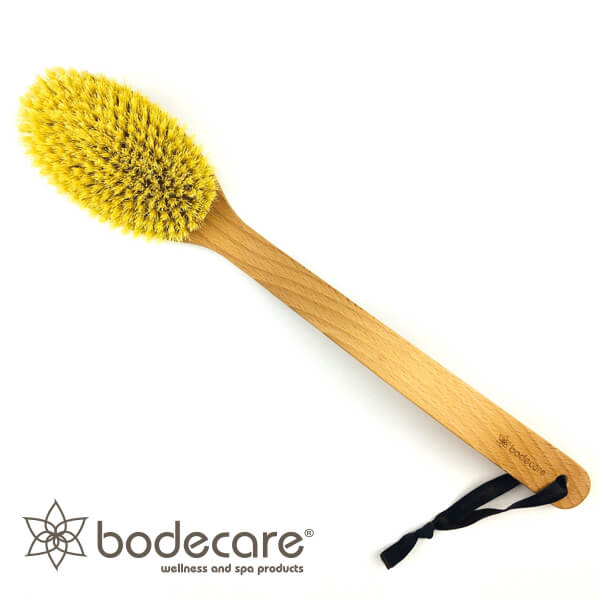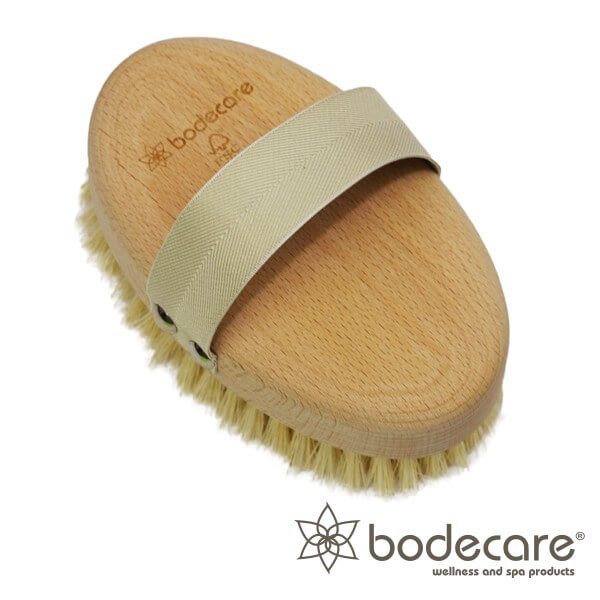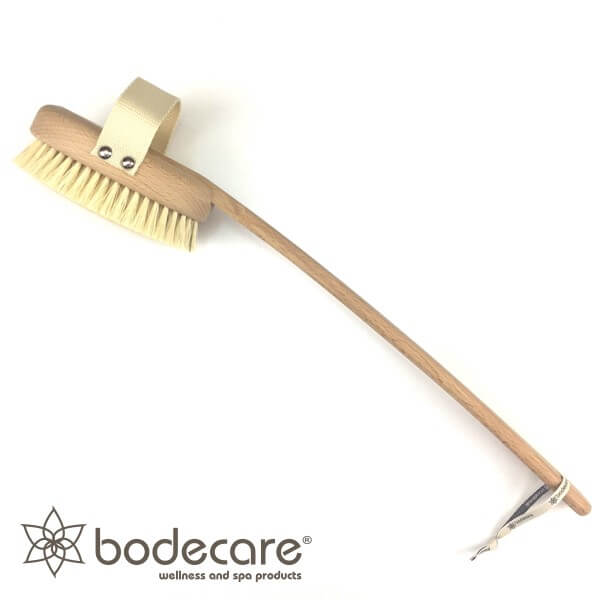


Body Brushing
call & collect yours today
Dry Body Brushing Benefits
Dry body brushing brings many health benefits with it, and because of this, it has been used for many years. It can help in the release of toxins, lead to an improvement in lymphatic drainage and venous blood circulation, reduce ingrown hair, exfoliate dead skin, and be of great assistance in reducing the effect of many skin conditions, like Eczema, Psoriasis, Keratosis Pilaris, and many other dry skin conditions.
Bodecare clients who are into body brushing have successfully used the technique of dry brushing for relieving arthritis, increasing scalp circulation, improving poor circulation, reducing stress, and removing bumpy skin from the back of the buttocks and legs so that for the first time in years they can have soft sexy skin on their legs.
When you go in for dry body brushing you need to take some precautions, like:
- Never brush the skin over any active inflammation, like open wounds, varicose veins, inflamed sores, or skin that is sunburnt. Never skin brush if you have enlarged lymph nodes or are in an active state of cancer.
- Avoid the areas of the breasts and genitalia
- Talk to your doctor, if you are pregnant
- Allergic reactions require you to stop brushing and tell your naturopath what has happened. Your body may just be detoxing, but even so, get advice from a naturopathic professional.
- Your skin will defoliate after body brushing, so it is best you regularly wash the brush to remove any dead skin from its bristles.
- Your skin can develop erythema or reddening of the skin, but this is normal, as it just means that your blood circulation is responding to the brushing of the skin.
Dry Skin Brushing Rules
- A plant bristle brush is best for dry brushing of the skin. These bristles can be soft, firm, or medium and your choice of the bristles must match what you require and are using it for, like removing cellulite, exfoliation, or circulation.
- Brush only on skin that is dry. This allows for the best exfoliation and stimulation. If plant bristles get wet, they will become soft and clump together, and prevent you from getting the results that you desire.
- As a rule, stroke upward in a single movement.
- Repeat light strokes 7 times
- Adjust pressure to levels that you are comfortable with
- Your brushing must be followed by some form of hydrotherapy, like having a shower or bath.
- Every Bodecare brush in our online shop allows you to download a booklet on body brushing that has diagrams showing the direction of brush strokes that go toward the lymphatic nodes.
Brush Maintenance
Make sure you rinse your brush after you have completed your brushing routine. Dry it in an open, sunny area to prevent mildew. Clean your brush once a week using soap and water. You should also avoid sharing your brush with anyone. This can help prevent the risk for infection.
If you have a skin condition, such as psoriasis, you should speak with your doctor before dry brushing. Be sure to avoid brushing over or around an open wound or infection.
Cellulite
Cellulite is a condition that mostly affects women. Areas affected by cellulite have a rippled or “cottage cheese” appearance. The cause is not fully known.
Massage has been shown to temporarily reduce the appearance of cellulite. Some claim that dry body brushing for cellulite can reduce the appearance of cellulite because it has similar effects on the body as massage. There’s no scientific data to support this theory, and it’s not a recognized treatment by most doctors.
“[Dry brushing] does exfoliate, which is fine if not done too vigorously,” says Dr. Carolyn Jacobs, a board-certified dermatologist and director at Chicago Cosmetic Surgery and Dermatology. “But it won’t help cellulite as that is due to fat and collagen bands in women.”
Exfoliation
The coarse bristles can brush away dry, dead cells from the skin. This can leave your skin more smooth and soft.
How to practice dry brushing
To dry brush, use a natural fiber brush with a long handle. The long handle will help you reach all areas of your body. Follow these steps:
Start at your feet and move up your body. Brush your skin using wide, circular, clockwise motions, useing only light pressure in areas where your skin is thin and harder pressure on thicker skin, like the soles of your feet. Brush your arms after you have brushed your feet, legs, and mid-section, and you should brush upward towards your armpits
After dry brushing, take a cool shower to help remove the dry skin.
After your shower, dry off, and then consider adding natural plant oil, such as olive or coconut oil, to moisturize your skin.
When you first start dry brushing, it’s best to begin with a light brushing. As you get used to it, you can increase the pressure.
Avoid sensitive areas and anywhere the skin is broken. These include areas with: rashes, wounds, cuts and infections.
Also, never brush an area affected by poison oak, poison ivy, or psoriasis. Don’t dry brush your face unless you’re using a softer brush made for that purpose.
Lymphatic system and the removal of toxins
The lymphatic system helps your body fight off infections. Fluids flow through the system and are filtered through the lymph nodes. If you’re sick or exposed to a lot of toxins, the system may become backed up and clogged. That is why your lymph nodes often become swollen when you have a cold.
Dry body brushing for circulation is thought to help the body release toxins through sweat. The coarse bristles on the brush stimulate the pores and open them up. This makes it easier for the body to sweat, which in turn reduces the number of toxins flowing through the lymphatic system.
There is little research to support this claim.
Relaxation
Similar to a massage, dry brushing may make you feel relaxed. To make the most of this benefit, practice dry brushing in a dark, quiet space.
What supplies do I need?
All you need to dry brush at home is a brush with natural fibre bristles. You should also look for one with a long handle to help you reach every part of your body.
We also recommend using the BiON Glycolic Skin Cream available in the clinic.
What are the risks of dry brushing?
Dry brushing may not be for everyone. If you have sensitive skin or a skin condition, such as psoriasis, speak with your doctor before dry brushing.
Some people should avoid dry brushing or proceed with caution. People with open or inflamed skin, including people with eczema and psoriasis, should avoid dry brushing over the inflamed area. You should also avoid dry brushing over an open wound. You could introduce bacteria to the wound, which could lead to infection.
